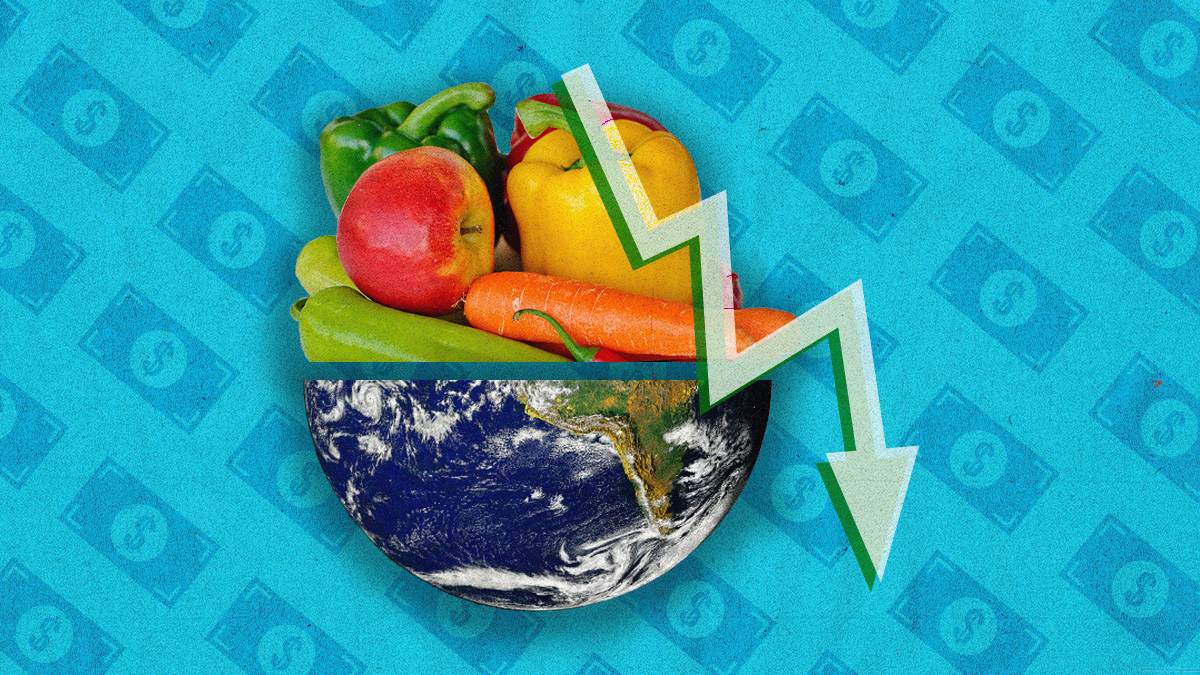July 20, 2022
Don’t look now, but one of the worst stories in the world is actually getting better. Slightly.
You’ve doubtless seen a lot about — and probably experienced — soaring global food prices in recent months. The pandemic drove up prices, and the war in Ukraine sent them to dizzying heights. Close to a billion people slid closer to famine and poverty.
Well, global food prices are actually falling now. In fact, they’ve been on their way down for several months.
The latest readout from the UN showed average food prices fell just over 2% in June, and 3.5% since March. More specifically, grain prices fell 4% last month, and vegetable oil prices have drizzled down 16% since sizzling to record highs this spring when the war of the sunflower superpowers began.
Why is this happening? The UN says higher prices have simply driven down global demand, and harvests look better than expected in big grain producers like Canada and Russia.
Meanwhile, Indonesia’s decision to reverse a crippling ban on palm oil exports has eased prices for cooking oils. And there is a prospect of further relief for global grain markets as Ukraine and Russia appear close to a deal to reopen Ukraine’s Black Sea export routes, which would immediately free up millions of tons of grain trapped in Ukrainian ports.
More broadly, says Peter Ceretti, a senior analyst with Eurasia Group, fears of a US recession are driving down commodities prices across the board.
That’s great news, right? Well, depends on your perspective, says David Laborde, a senior researcher at the International Food Policy Research Institute. Prices are still 23% higher than they were a year ago and 60% higher than before the pandemic, when lockdowns and worker shortages crimped food supply chains around the world.
“We went from very high to extremely high,” he says. “Now we’re simply back to very high.”
The basic problem is still the same. As economies roared back from the pandemic in 2021, global demand for food exceeded supplies that had been undercut by lockdowns, labor shortages, and bad weather. That drained the world’s food inventories, even before the war in Ukraine dealt an added shock to prices. At the same time, the pandemic crippled the disposable income of billions of people around the world, making it harder for them to afford food.
Right now, says Laborde, what we need is a year where supply exceeds demand so that the world can get back to normal. Could the next year be that year?
Looking ahead, a lot rides on what happens with 2023 harvests, and that’s a function of two things that farmers need in order to produce bountiful crops: good weather and cheap fertilizer.
On the weather front, it’s anyone’s guess what nature has in store, particularly given the increasing frequency of extreme weather events (Europe, the floor is yours at the moment.)
But access to affordable fertilizers is also a huge concern. Half of the world’s people consume a diet dependent on fertilizers, according to Ertharin Cousin, former head of the UN’s World Food Program.
Fertilizer prices have risen to historic highs because of high costs for natural gas, a key input for some fertilizers, as well as export restrictions from key producers like China. The war and sanctions disrupted supplies from Russia and Belarus, both leading potash manufacturers. None of the three factors is likely to subside quickly, and farmers need to plant their 2023 crops soon.
Wait, my grocery bill is still ridiculous — why? Lower prices for basic staples like wheat or cooking oils don’t necessarily translate into lower prices at the register, and certainly not immediately.
For one thing, the cost of those inputs may be only a small part of the price you see on the tag. In the US, for example, the price of wheat is only about 5% of the cost of a loaf of bread, says Laborde. The rest of that price comes from other production and shipping costs, all of which are high because of broader inflationary pressures.
“If you’re a bakery in New York City, you’re probably more worried about the cost of your lease than you are about global prices for wheat,” Laborde says.
Meanwhile, in low- and middle-income countries, the basic challenges of food security won’t ease much in the near term, according to Ceretti. Any lower prices will take time to pass through to local markets in these countries. What’s more, he points out, households there typically spend up to 40% of their budget on food as is.
“Imagine how it would feel if something that eats up 40% of your household budget rose in price by a quarter or more in the past year,” says Ceretti. The recent drop of a few percentage points might not even make a dent for you.
More For You
Of all the threats to the world, what are the top 10 most urgent global risks for 2026? On Monday, January 5, at 12 pm ET, join us for a livestream discussion with Ian Bremmer and global experts to discuss the Top Risks of 2025 report from Eurasia Group. This report will mark twenty years of Ian Bremmer’s annual forecast of the political risks that are most likely to play out over the year. Event link: gzeromedia.com/toprisks
Most Popular
- YouTube
Wikipedia cofounder Jimmy Wales explains why a specific page titled “The Gaza Genocide” risks undermining trust with users.
- YouTube
In his latest Quick Take, Ian Bremmer explains a major shift in the Ukraine war: Europe, not the United States, is now driving the strategy.
Chief Superintendent of the police force's National Security Department Steve Li Kwai-wah speaks at the West Kowloon Magistrates' Courts building after the verdict in the national security collusion trial of Jimmy Lai, founder of the now-defunct pro-democracy newspaper Apple Daily, in Hong Kong, China, on December 15, 2025.
REUTERS/Lam Yik
© 2025 GZERO Media. All Rights Reserved | A Eurasia Group media company.
